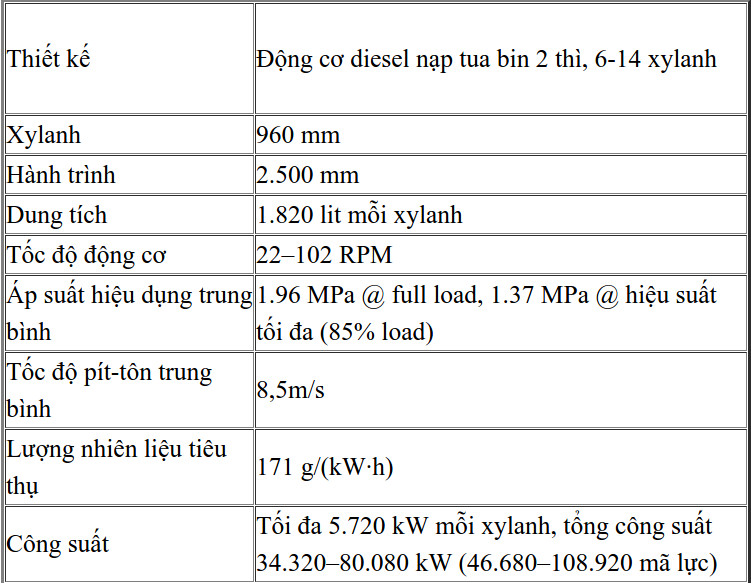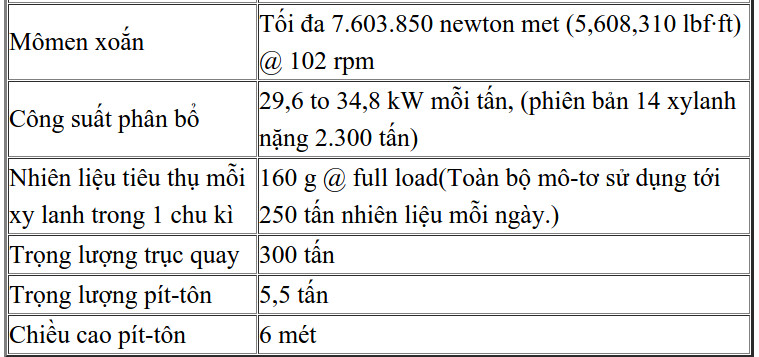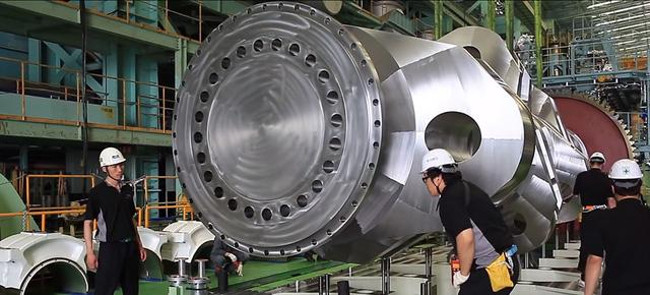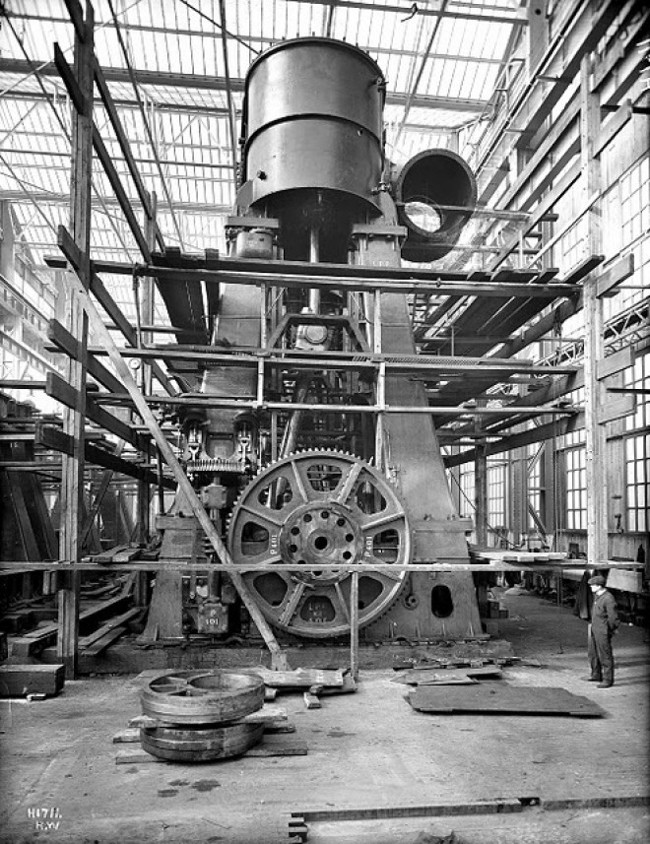Amazing engine in the world, 9 times stronger than the Titanic engine
Wärtsilä a Finnish manufacturer designed a slow-loading two-stroke diesel engine to operate heavy liquid fuel-powered container ships called Wärtsilä RT-flex96C . The largest version has 14 cylinders, as high as 13.5m, with a 4-storey building, 26.59m long and 2,300 tons heavier, has a capacity of 80,080 kilowatts (107,390 horsepower). And this is the world's largest piston engine.
Structure of RT-flex96C
In September 2006, this version was commissioned on the Emma Mærsk ship with the most advanced technology at the time. By using bracing technology instead of using traditional camshafts, chains, fuel pumps and hydraulic drives make the engine operate at maximum number of rounds per minute, helping to save fuel and reduce air emissions. toxic.

The world's largest piston engine.
Since the engine has a cross-ball bearing, the piston arm is always upright, creating an enclosed chamber, so each different part uses its own lubricant.
The cylinder is lubricated by a lubricant delivery system that can cyclically protect the cylinder from wear and neutralize the acids produced by the combustion of sulfur-rich fuel. The cross-shaped design reduces the lateral pressure on the piston, keeping the level of wear on the cylinder lining within 0.03mm / 1000 hours of operation.
Engine exhaust air through waste valves is operated by electronic system, hydraulic bracing - eliminates camshaft.

14 cylinder version
The plunger piston is used to compress the gas for the adjacent cylinders, in addition to the piston cushion function before reaching the bottom die to reduce the pressure on the bearing. The engine discharges linearly through exhaust valves controlled by electronic systems and hydraulic rail systems - instead of using camshafts.



In 2006, more than 300 RT-flex96C engines and old RTA96C engines were put into production
Manufacturing process of RT-flex96C engine
Titanic engine
The Titanic was equipped with the most advanced engines of the time by the manufacturer in the hope of achieving higher capacity without additional steam.
Parson's low-pressure turbine turbine with steam engines run at 75 revolutions per minute and generate 30,000 horsepower.
The turbine engine runs at a speed of 165 revolutions per minute and generates 16,000 horsepower to operate the Titanic's central propeller. AC motors operate propellers on both sides of the ship. These propellers have a radius of 7.1 meters and a central presser with a radius of 4.8 meters. The maximum speed of the ship is 23-24 knots.

Each port and right side of the ship has a 3-wing 3- inch propeller driven by an AC motor. A central propeller radius of 4.8 meters operated by a turbine engine is placed on a midline directly below the rudder.
The AC motors are designed to operate with a capacity of 15,000 horsepower at a speed of 75 revolutions per minute. The turbine is designed to produce 16,000 cylindrical horsepower (SHP) at a speed of 165 revolutions per minute. Under these conditions, it is estimated that the ship is 21 nautical miles per hour.
In theory, the Titanic's propulsion has a capacity of 50,000 horsepower. When the rotation speed is about 78 rounds per minute, the train can run at speeds of more than 22.5 knots. When running an AC engine at 83 revolutions per minute, the total power can be up to 59,000 horsepower with 18,000 horsepower for the turbine. In this mode the ship can run up to 24 knots.
You should read it
May be interested
- Use materials that are 200 times stronger than steel to build rubber bands
 alliance rubber, the world's largest rubber band manufacturer, is researching to produce rubber bands from graphene, the world's most durable material.
alliance rubber, the world's largest rubber band manufacturer, is researching to produce rubber bands from graphene, the world's most durable material. - The world's strongest magnet can generate a magnetic field of 45.22 tesla, one million times stronger than the Earth's magnetic field.
 on august 12, researchers at the stable strong magnetic field facility (shmff) in hefei, anhui province, china put into operation the world's strongest magnet for scientific research.
on august 12, researchers at the stable strong magnetic field facility (shmff) in hefei, anhui province, china put into operation the world's strongest magnet for scientific research. - If you suffer from the world's most poisonous spider, how will your body be destroyed?
 the little spider has a name that evokes death. the black widow is listed as one of the 10 most terrifying animals in the world. because they possess the amount of venom secreted in a single bite, it is 15 times stronger than the venom of a snake's tail.
the little spider has a name that evokes death. the black widow is listed as one of the 10 most terrifying animals in the world. because they possess the amount of venom secreted in a single bite, it is 15 times stronger than the venom of a snake's tail. - 7 harsh facts of life help you be stronger
 everyone in each of us has a good side - bad, good - evil, strong - weak, and it's hard to acknowledge the dark parts of ourselves. to help people understand themselves as well as change some negative aspects that life brings, this article has summarized 7 useful tips to help everyone's spirit become stronger.
everyone in each of us has a good side - bad, good - evil, strong - weak, and it's hard to acknowledge the dark parts of ourselves. to help people understand themselves as well as change some negative aspects that life brings, this article has summarized 7 useful tips to help everyone's spirit become stronger. - Successfully tested the Mach 5 engine
 the mach 5 is about 50% faster than the world's fastest jet engine - sr-71 blackbird.
the mach 5 is about 50% faster than the world's fastest jet engine - sr-71 blackbird. - How scary is the poison VX, the most terrifying neurotoxin in the world?
 vx is a neurotoxin that is considered to be the most powerful man ever created. it is 100 times stronger than srarin - a deadly poison in minutes in very small doses. the united nations has classified this poison as a list of weapons of mass destruction.
vx is a neurotoxin that is considered to be the most powerful man ever created. it is 100 times stronger than srarin - a deadly poison in minutes in very small doses. the united nations has classified this poison as a list of weapons of mass destruction. - How to Paint an Engine Bay
 painting your engine bay can be a great way to set your vehicle apart or just generally improve its looks when you have the hood open. optimally, you should paint your engine bay with the engine completely removed, but even if you're not...
painting your engine bay can be a great way to set your vehicle apart or just generally improve its looks when you have the hood open. optimally, you should paint your engine bay with the engine completely removed, but even if you're not... - 7 times of escaping death within a short time, winning the lottery 4 times in your life ... these are the luckiest people in the world
 do you believe that there are lucky people 7 times out of the hands of death, lightning does not die but also help brighten the eyes, winning 4 times lottery in life with a total prize of up to 20.3 million usd. ..
do you believe that there are lucky people 7 times out of the hands of death, lightning does not die but also help brighten the eyes, winning 4 times lottery in life with a total prize of up to 20.3 million usd. .. - How to Paint an Engine Block
 the engine block refers to the metal and plastic casing surrounding the components in your engine. when people talk about painting an engine, they're really just talking about painting the engine block since you can't get paint on the...
the engine block refers to the metal and plastic casing surrounding the components in your engine. when people talk about painting an engine, they're really just talking about painting the engine block since you can't get paint on the... - How to add custom search engine in Thunderbird
 adding a custom search engine in mozilla thunderbird is difficult and prone to compatibility errors. follow the procedure below to access your favorite search engine from this email client!
adding a custom search engine in mozilla thunderbird is difficult and prone to compatibility errors. follow the procedure below to access your favorite search engine from this email client!










 The most impressive world record in 2017
The most impressive world record in 2017 15 simple habits that help you live happier
15 simple habits that help you live happier Very rare white killer whales found
Very rare white killer whales found 'Hunting' season and bloody 'carnage' dolphins in Taiji, Japan
'Hunting' season and bloody 'carnage' dolphins in Taiji, Japan Is Proxima b our 'neighbor' planet?
Is Proxima b our 'neighbor' planet? Water can 'cut sweet' concrete and steel. Do you believe that?
Water can 'cut sweet' concrete and steel. Do you believe that?